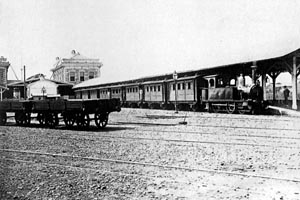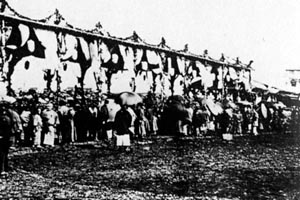Frederick Collier Christy
|
Job content of the Locomotive Superintendent of the Japanese Government Railway during 1870s. The Locomotive Superintendent job was the planning of the maintenance and operation of all the vehicles, such as a passenger cars, freight cars and locomotives, and the job also included the works manager. The train operation plan included duties of Traffic Manager. In addition, the Traffic Manager had authority of decision in service times and the driving schedule. The job prepared locomotives, passenger and freight cars, and actual running of a train, that according to an agenda from the Traffic Manager's planning, this was the job of the Locomotive Superintendent. According to job requirements in June 1872, the job of the Locomotive Superintendent had no provisions regarding the work of the foreigner. However, on the 19th of May 1873, the published prescription clearly mentioned the following hiring of individual foreign engineers for the positions of , : the Secretary of the Transportation, the Transportation Equipment Superintendent, President of the Transportation Equipment, and the Vehicle Dispatch Controller. Therefore, it clearly defines the requirements of the Locomotive Superintendent from the beginning.
According to the prescription of job category at that time, the job category had two types of Transportation-Engineer and Engineering-Division. The Transportation-Engineer is the now the 'Driving', and the Engineering-Division is the 'Production and Maintenance' This two sections were unified as ' Locomotive Division ' and was established during July of 1883. The Locomotive Division's job was given to the 'Driving of the train' and the 'Manufacturing and maintenance of the vehicles', as a 'Branch Regulation in the Railway Bureau' during January of 1886. However, actually the 'Locomotive Superintendent' was doing such works from the beginning. Afterward, the section name became the Locomotive Superintendent in due form during December of 1890, and deployed the employed foreigner at Shimbashi and Kobe, one by one. But, Japanese were employed aside from a foreigner, as a Locomotive-Chief. So, the purpose of a foreigner had no teeth ... and was almost a kind of adviser position. From the fully opened Tokaido line during July of 1889, the foreigner Locomotive Superintendent's real power dropped off little by little. |
|
First Locomotive Superintendent Frederick Collier Christy, in Shimbashi office. Frederick Collier Christy was first employed by the Japanese government during April 1871 when his age was 49 years old. His annual salary was 400 dollars per year for the next five years. Usually the other foreign engineers contracts got a regular raise every 2 or 3 years, but, his salary was still 400 dollars after five years because maybe he was the oldest engineer of the high-ranking personnel. His career before he came to Japan, is not well understood. But he was a unique engineer, because he got a position of Locomotive-Superintendent which in a small foreign country with only a total of 20 locomotives, was unique for his age of 49 years. If he had been promoted in a regular manner in his own country or overseas, he would have already been a Locomotive Superintendent of a large railway company at that age of 49.
When Japan's first railroad was opened between Tokyo and Yokohama during October 1872, nine foreigners were commended from the government. Oriental-Bank was an associate, as was W.W.Cargill as an individual .... etc. Also Frederick Collier Christy was commended as a Sub-Secretary of Transportation. During 1871, Christie signed an employment contract with the Japanese Government Railway via the Oriental-Bank. During later years when viewed in retrospect, perhaps, the actual content of his employment would have been clear from his contract. The contractual coverage was not a matter of convenience from the Japanese end, but according to the list of foreigner engineers on the 26th of December 1872, his post was not Sub-Secretary, but was Locomotive Superintendent. I don't know the real reason for the change, due to the uncertainty of the annual foreign engineers employment list. However, I am not sure, why Christy did not come as a technical engineer, perhaps, he came from an engine driver apprentice background. Therefore, he worked as a Sub-Secretary of transportation at first, but, later, he was promoted to Locomotive-Superintendent, for reasons of expediency. So, he seems to be completely not involved for the locomotive's design or for orders ... He turned in his report about the condition of the locomotives to the chief building engineer R.V. Boyle during February 1873, that Japanese translation still remains. Of the imported ten engines, six Sharp Stewart and Avonside Engine's 2-4-0 tank engines were in good enough condition for the service, because, there was little transport volume between Tokyo and Yokohama at that time. Therefore, because of poor performance, four 2-4-0 engines of the Vulcan Foundry, Dubs and Yorkshire Engine Company were not scheduled for remodeling. Furthermore, one reason was maybe he wasn't very confident of the modeling and also because of poor equipment in the workshop. No reason was given for his removal from his post during September 1876, and he returned home apparently in good health. He was interested in insect study during his stay in Japan, he was particularly interested in a specific moth. And he collected many moths. When he went back to his own country, he gave moth specimens to his friend, a part of this collection is in the British-Museum. During October 1972, a Japanese entomologist, Jin Hasegawa wrote for Asahi a News paper with the title of ' Centennial anniversary of the Railway, a Foreigner and a species of Insect '. According to that article, when Christie stayed in Australia, he contributed for a magazine with the title of ' A diary of Japan '. However, most of the contents were about insects, there was little written about Japanese railroads .... |
|
Authorization from The Railway Pictorial No.288 Foreign Locomotive Superintendent by K.Kawakami. |
|
Recently, I received one email from Australia. Surprisingly, it came from a descendant of F.C. Christy. The email was written from the biog of Christie who was yet unknown in Japan. As presented above, Japan's railroad history has very little of Christie's archival record which before he came to Japan's UK time, and after he left Japan in the days of Australia. I think, this letter was taken from research of Japanese railway history in an early era as a one step further. I am posting here from Christie's descendant his description in agreement. I'm grateful to Alison !! |
|
Frederick Collier CHRISTY, Civil Engineer, was my Grandfather's Gt Gt Uncle.
He was born into the famous Hatting firm Christys' of London.
Frederick migrated to Victoria from England where he married and had one daughter Edith who died unmarried. Frederick was a Locomotive Engineer with the Victorian Railways. He played First Grade cricket for the Surrey X1 and was a member of the Victorian Science Institute, Engineers Association, Field Naturalists Club, Horticultural Society and the Royal Society and was an avid contributor to various newspapers in Victoria. In the 1870's he took up an appointment with the Imperial Railways of Japan in Yokohama. After several years service, he returned to Victoria. He continued his involvement in his varied interests over many years until his death in South Yarra, Victoria in 1909. Alison, Australia |
Introduction
|
Go to Top
|

